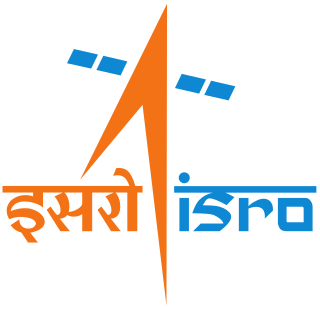
The Indian National Satellite System or INSAT, is a series of multipurpose geostationary satellites launched by the Indian Space Research Organisation (ISRO) to satisfy telecommunications, broadcasting, meteorology, and search and rescue operations. Commissioned in 1983, INSAT is the largest domestic communication system in the Indo-Pacific Region. It is a joint venture of the Department of Space, Department of Telecommunications, India Meteorological Department, All India Radio and Doordarshan. The overall coordination and management of INSAT system rests with the Secretary-level INSAT Coordination Committee.

Geosynchronous Satellite Launch Vehicle (GSLV) is a class of expendable launch systems operated by the Indian Space Research Organisation (ISRO). GSLV has been used in fifteen launches since 2001.

The Indian Space Research Organisation is India's national space agency. It serves as the principal research and development arm of the Department of Space (DoS), overseen by the Prime Minister of India, with the Chairman of ISRO also serving as the chief executive of the DoS. It is primarily responsible for space-based operations, space exploration, international space cooperation and the development of related technologies. The agency maintains a constellation of imaging, communication and remote sensing satellites. It operates the GAGAN and IRNSS satellite navigation systems. It has sent three missions to the Moon and one mission to Mars.
GSAT-3, also known as EDUSAT, was a communications satellite which was launched on 20 September 2004 by the Indian Space Research Organisation. EDUSAT is the first Indian satellite built exclusively to serve the educational sector. It is mainly intended to meet the demand for an interactive satellite-based distance education system for the country.

The GSAT satellites are India's indigenously developed communications satellites, used for digital audio, data and video broadcasting. As of 5 December 2018, 20 GSAT satellites manufactured by ISRO have been launched, out of which 14 are in service.

The Launch Vehicle Mark-3 or LVM3 is a three-stage medium-lift launch vehicle developed by the Indian Space Research Organisation (ISRO). Primarily designed to launch communication satellites into geostationary orbit, it is also due to launch crewed missions under the Indian Human Spaceflight Programme. LVM3 has a higher payload capacity than its predecessor, GSLV.

GSAT-4, also known as HealthSat, was an experimental communication and navigation satellite launched in April 2010 by the Indian Space Research Organisation on the maiden flight of the Geosynchronous Satellite Launch Vehicle Mk.II rocket. It failed to reach orbit after the rocket's third stage malfunctioned. The third stage was the first Indian-built cryogenic-fuelled upper stage, and was making its first flight. The ISRO suspects that the failure was caused by the third stage not igniting.
GSAT-5P, or GSAT-5 Prime, was an Indian communications satellite which was lost in a launch failure in December 2010. Part of the Indian National Satellite System, it was intended to operate in geosynchronous orbit as a replacement for INSAT-3E.
GSAT-14 is an Indian communications satellite launched in January 2014. It replaced the GSAT-3 satellite, which was launched in 2004. GSAT-14 was launched by a Geosynchronous Satellite Launch Vehicle Mk.II, which incorporated an Indian-built cryogenic engine on the third stage.
GSAT-10 is an Indian communication satellite which was launched by Ariane-5ECA carrier rocket in September 2012. It has 12 KU Band, 12 C Band and 6 lower extended c band transponders, and included a navigation payload to augment GAGAN capacity. Following its launch and on-orbit testing, it was placed in Geosynchronous orbit at 83.0° East, from where it will provide communication services in India.

GSAT-11 is an Indian geostationary communications satellite. The 5854 kg satellite is based on the new I-6K Bus and carries 40 transponders in the Ku-band and Ka-band frequencies, which are capable of providing up to 16 Gbit/s throughput. GSAT-11 is India's heaviest satellite.

INSAT-4E, also known as GSAT-6, is a member of the INSAT family and is a multimedia communication satellite that will offer a Satellite Digital Multimedia Broadcasting (S-DMB) service across several digital multimedia terminals or consoles which can be used to provide information services to vehicles on the fly and to the mobile phones. The satellite can be used for other social and strategic applications.
GSAT-7 or INSAT-4F is a multi-band military communications satellite developed by the Indian Space Research Organisation. The Indian Navy is the user of the multi-band communication spacecraft, which has been operational since September 2013. According to defense experts, the satellite will enable the navy to extend its blue water capabilities and stop relying on foreign satellites like Inmarsat, which provide communication services to its ships.

GSAT-7A is an advanced military communications satellite meant primarily for the Indian Air Force with Indian Army using 30% of capacity.

GSAT-19 is an Indian communications satellite launched by the Indian Space Research Organisation aboard an LVM3 on 5 June 2017.

GSAT-6A was a communication satellite launched by the Indian Space Research Organisation (ISRO). It featured a 6-metre (20 ft) unfurlable S-band antenna similar to the one used on GSAT-6. Around 17 minutes after lift-off, the three stage GSLV Mk.II rocket flying on GSLV F08 mission successfully injected the satellite into a geosynchronous transfer orbit. Due to power failure during its orbit raising burns the communication was lost with GSAT-6A before it could reach its final circular geostationary orbit (GSO).

GSAT-29 is a high-throughput communication satellite developed by the Indian Space Research Organisation (ISRO). The mission aims at providing high-speed bandwidth to Village Resource Centres (VRC) in rural areas. The two Ku and Ka operational payloads will provide communication services to Jammu and Kashmir and Northeast India under Digital India programme. At the time of launch GSAT-29 was the heaviest satellite, weighing 3,423 kg (7,546 lb), that was placed in orbit by an Indian launch vehicle. Approved cost of GSAT-29 is ₹175.63 crore (US$21 million).

The Defence Space Agency (DSA) is an integrated tri-services agency of the Indian Armed Forces headquartered in Bengaluru, Karnataka, India. The agency is tasked with operating the space-warfare and Satellite Intelligence assets of India. The DSA draws personnel from all three branches of the Armed Forces.
















